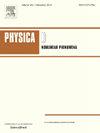基于加权可见性图的深度复杂网络特征:阿尔茨海默病自发语言的新诊断标记
IF 2.7
3区 数学
Q1 MATHEMATICS, APPLIED
引用次数: 0
摘要
识别自发语音信号的动态复杂性变化可作为早期诊断阿尔茨海默病(AD)的重要标准。在计算几何的框架下,利用自发语音信号中嵌入的信息;本文介绍了一种新的区分健康受试者与三阶段AD患者言语多样性差异的方法。鉴于语音信号的动态和非线性特性,基于节点间强度的概念,提出了加权可见性图(WVG)作为一种定量方法。使用加权平均度和模块化两个标准分析了四组人之间网络的差异复杂性。采用基于长短期记忆(LSTM)网络的深度体系结构,根据其处理wvg特征的性能对AD阶段进行分类。结果表明,该算法在检测AD早期阶段具有较好的准确性。它可以将语音信号分为四组,准确率高达99.75%。此外,该方法有可能通过揭示四组语言反应的显著差异,使我们更容易采用语音生成系统的运行状态和影响语言技能的中枢神经系统疾病。因此,它可以作为临床前阶段评估AD的一个有价值的工具。本文章由计算机程序翻译,如有差异,请以英文原文为准。
Weighted Visibility Graph-based Deep Complex Network Features: New Diagnostic Spontaneous Speech Markers of Alzheimer's Disease
Recognition of dynamic complexity changes in spontaneous speech signals can be regarded as a significant criterion for the early diagnosis of Alzheimer's disease (AD). Using the information embedded in spontaneous speech signals, in the framework of computational geometry; this paper introduces a new method for classifying speech diversity differences of healthy subjects compared to those with three stages of AD. Due to the dynamic and nonlinear nature of the speech signals, a weighted visibility graph (WVG) is proposed as a quantitative approach based on the concept of strength between nodes. The differential complexities of the network among the people of the four groups are analyzed using two criteria: average weighted degree and modularity. A long short-term memory (LSTM) network-based deep architecture is used to classify AD stages allied to its performance dealing with WVG-based features. The results show that the proposed algorithm has outstanding accuracy compared to its rivals in detecting the early stages of AD. It can classify speech signals into four groups with a high accuracy of 99.75%. In addition, the proposed approach has the potential to make it much easier to adopt the running state of the speech generation system and the central nervous system disorders affecting language skills by revealing significant differences between the speech reactions of the four mentioned groups. Therefore, it can be a valuable tool for evaluating AD in its preclinical stages.
求助全文
通过发布文献求助,成功后即可免费获取论文全文。
去求助
来源期刊

Physica D: Nonlinear Phenomena
物理-物理:数学物理
CiteScore
7.30
自引率
7.50%
发文量
213
审稿时长
65 days
期刊介绍:
Physica D (Nonlinear Phenomena) publishes research and review articles reporting on experimental and theoretical works, techniques and ideas that advance the understanding of nonlinear phenomena. Topics encompass wave motion in physical, chemical and biological systems; physical or biological phenomena governed by nonlinear field equations, including hydrodynamics and turbulence; pattern formation and cooperative phenomena; instability, bifurcations, chaos, and space-time disorder; integrable/Hamiltonian systems; asymptotic analysis and, more generally, mathematical methods for nonlinear systems.
 求助内容:
求助内容: 应助结果提醒方式:
应助结果提醒方式:


